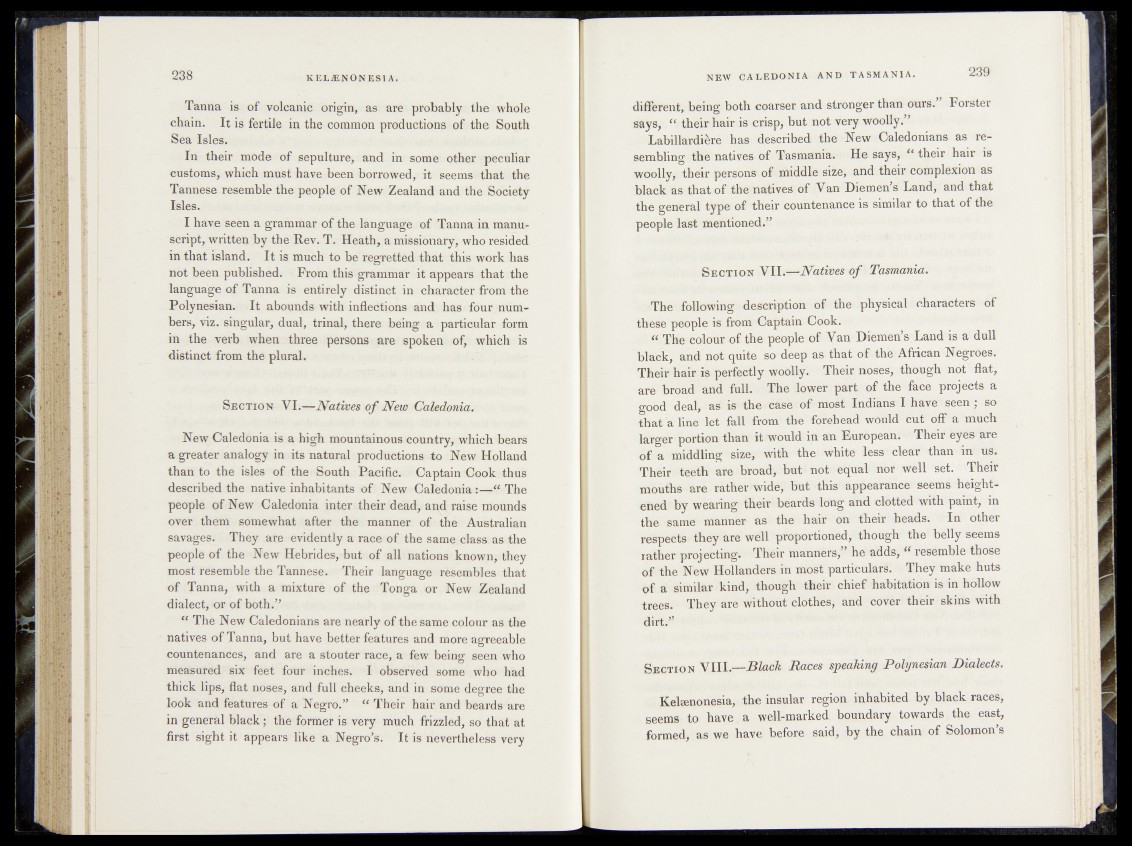
Tanna is of volcanic origin, as are probably tbe whole
chain. It is fertile in the common productions of the South
Sea Isles.
In their mode of sepulture, and in some other peculiar
customs, which must have been borrowed, it seems that the
Tannese~resemble the people of New Zealand and the Society
Isles.
I have seen a grammar of the language of Tanna in manuscript,
written by the Rev. T. Heath, a missionary, who resided
in that island. It is much to be regretted that this work has
not been published. From this grammar it appears that the
language of Tanna is entirely distinct in character from the
Polynesian. It abounds with inflections and has four numbers,
viz. singular, dual, trinal, there being a particular form
in the verb when , three persons ;are spoken of, which is
distinct from the plural.
S ection VI.—Natives o f New Caledonia.
New Caledonia is a high mountainous country, which bears
a greater analogy in its natural productions to New Holland
than to the isles of the South Pacific. Captain Cook thus
described the native inhabitants of New Caledonia:—“ The
people of New Caledonia inter their dead, and raise mounds
over them somewhat after the manner of the Australian
savages; They are evidently a race of the same class as the
people of the New Hebrides, but of all nations known, they
most resemble the Tannese. Their language resembles that
of Tanna, with a mixture of the Tonga or New Zealand
dialect, or of both.”
“ The New Caledonians are nearly of the same colour as the
natives of Tanna, but have better features and more agreeable
countenances, and are a stouter race, a few being seen who
measured six feet four inches. I observed some who had
thick lips, flat noses, and full cheeks, and in some degree the
look and features of a Negro.” “ Their hair and beards are
in general black; the former is very much frizzled, so that at
first sight it appears like a Negro’s. It is nevertheless very
different, being both coarser and stronger than ours.” Forster
says, their hair is crisp* but not very woolly.”
Labillardikre has described the New Caledonians as resembling
the natives of Tasmania. He says, “ their hair is
woolly, their persons of middle size, and their complexion as
black as that of the natives of Van Diemen’s Land, and that
the general type of their countenance is similar to that of the
people last mentioned.”
§ S ection V II.—Natives o f Tasmania.
The following description of the physical characters of
these people is from Captain Cook.
« The colour of the people of Van Diemen’s Land is a dull
black, and not quite so deep as that of the African Negroes.
Their hair is perfectly woolly. Their noses, though not flat,
are broad and full. The lower part of the face projects a
good deal, as is the- case of most Indians I have seen ; so
that a line let fall from the forehead would cut off a much
larger portion than it would in an European. Their eyes are
of a middling size, with the white less clear than in us.
Their teeth are broad, but not equal nbr well set. Their
mouths are rather wide, but this appearance seems heightened
by wearing their beards long and clotted with paint, in
the same manner as the hair on their-heads. In other
respects they are well proportioned, though the belly seems
rather projecting. Their manners,” he adds, « resémble those
of the New Hollanders in most particulars. They make huts
of a similar kind, though their chief habitation is in hollow
trees. They are without clothes, and cover their skins with
dirt:’’
S e c t io n VIII.—Slack Races speaking Polynesian Dialects.
Kehenonesia, the insular region inhabited by black races,
seems to have, a well-marked; boundary towards the east,
formed, as we have before said, by the chain of Solomon’s